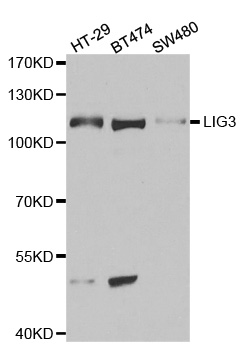DNA ligase III antibody [1F3]
GTX70143
ApplicationsImmunoFluorescence, ImmunoPrecipitation, Western Blot, ImmunoCytoChemistry, Neutralisation/Blocking, Other Application
Product group Antibodies
TargetLIG3
Overview
- SupplierGeneTex
- Product NameDNA ligase III antibody [1F3]
- Delivery Days Customer9
- Application Supplier NoteWB: 1:500-1:3000. *Optimal dilutions/concentrations should be determined by the researcher.Not tested in other applications.
- ApplicationsImmunoFluorescence, ImmunoPrecipitation, Western Blot, ImmunoCytoChemistry, Neutralisation/Blocking, Other Application
- CertificationResearch Use Only
- ClonalityMonoclonal
- Clone ID1F3
- Concentration1 mg/ml
- ConjugateUnconjugated
- Gene ID3980
- Target nameLIG3
- Target descriptionDNA ligase 3
- Target synonymsLIG2, LIG3alpha, MTDPS20, DNA ligase 3, ligase II, DNA, ATP-dependent, ligase III, DNA, ATP-dependent, polydeoxyribonucleotide synthase [ATP] 3
- HostMouse
- IsotypeIgG1
- Protein IDP49916
- Protein NameDNA ligase 3
- Scientific DescriptionThis gene is a member of the DNA ligase family. Each member of this family encodes a protein that catalyzes the joining of DNA ends but they each have a distinct role in DNA metabolism. The protein encoded by this gene is involved in excision repair and is located in both the mitochondria and nucleus, with translation initiation from the upstream start codon allowing for transport to the mitochondria and translation initiation from a downstream start codon allowing for transport to the nucleus. Additionally, alternate transcriptional splice variants, encoding different isoforms, have been characterized. [provided by RefSeq, Jul 2008]
- Storage Instruction-20°C or -80°C,2°C to 8°C
- UNSPSC12352203
References
- Rubio-Contreras D, Gómez-Herreros F. TDP1 suppresses chromosomal translocations and cell death induced by abortive TOP1 activity during gene transcription. Nat Commun. 2023,14(1):6940. doi: 10.1038/s41467-023-42622-7Read this paper
- Nie L, Wang C, Huang M, et al. DePARylation is critical for S phase progression and cell survival. bioRxiv. 2024,:pii: 2023.07.31.551317. doi: 10.1101/2023.07.31.551317.Read this paper
- Cong K, Peng M, Kousholt AN, et al. Replication gaps are a key determinant of PARP inhibitor synthetic lethality with BRCA deficiency. Mol Cell. 2021,81(15):3128-3144.e7. doi: 10.1016/j.molcel.2021.06.011Read this paper
- Shamanna RA, Lu H, de Freitas JK, et al. WRN regulates pathway choice between classical and alternative non-homologous end joining. Nat Commun. 2016,7:13785. doi: 10.1038/ncomms13785Read this paper
- Szczesny B, Marcatti M, Zatarain JR, et al. Inhibition of hydrogen sulfide biosynthesis sensitizes lung adenocarcinoma to chemotherapeutic drugs by inhibiting mitochondrial DNA repair and suppressing cellular bioenergetics. Sci Rep. 2016,6:36125. doi: 10.1038/srep36125Read this paper
- Horton JK, Stefanick DF, Prasad R, et al. Base excision repair defects invoke hypersensitivity to PARP inhibition. Mol Cancer Res. 2014,12(8):1128-39. doi: 10.1158/1541-7786.MCR-13-0502Read this paper
- Moscariello M, Iliakis G. Effects of chromatin decondensation on alternative NHEJ. DNA Repair (Amst). 2013,12(11):972-81. doi: 10.1016/j.dnarep.2013.08.004Read this paper
- Horton JK, Stefanick DF, Gassman NR, et al. Preventing oxidation of cellular XRCC1 affects PARP-mediated DNA damage responses. DNA Repair (Amst). 2013,12(9):774-85. doi: 10.1016/j.dnarep.2013.06.004Read this paper
- Masaoka A, Gassman NR, Horton JK, et al. Interaction between DNA Polymerase β and BRCA1. PLoS One. 2013,8(6):e66801. doi: 10.1371/journal.pone.0066801Read this paper
- Paul K, Wang M, Mladenov E, et al. DNA ligases I and III cooperate in alternative non-homologous end-joining in vertebrates. PLoS One. 2013,8(3):e59505. doi: 10.1371/journal.pone.0059505Read this paper




